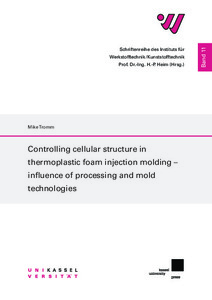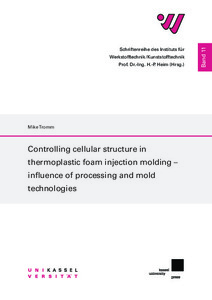| dc.date.accessioned | 2021-02-08T08:58:50Z | |
| dc.date.available | 2021-02-08T08:58:50Z | |
| dc.date.issued | 2020 | |
| dc.identifier | doi:10.17170/kobra-202008261646 | |
| dc.identifier.uri | http://hdl.handle.net/123456789/12466 | |
| dc.description | Zugleich: Dissertation, Universität Kassel, 2020 | ger |
| dc.language.iso | eng | eng |
| dc.publisher | kassel university press | |
| dc.rights | Namensnennung - Weitergabe unter gleichen Bedingungen 4.0 International | * |
| dc.rights.uri | http://creativecommons.org/licenses/by-sa/4.0/ | * |
| dc.subject | foam injection molding | eng |
| dc.subject | core-back | eng |
| dc.subject | mold-opening | eng |
| dc.subject | cellular plastics | eng |
| dc.subject | structure development | eng |
| dc.subject | process-structure relationship | eng |
| dc.subject | lightweight construction | eng |
| dc.subject.ddc | 600 | |
| dc.subject.ddc | 660 | |
| dc.title | Controlling cellular structure in thermoplastic foam injection molding – influence of processing and mold technologies | eng |
| dc.type | Buch | |
| dcterms.abstract | Foam injection molding is a processing technology to produce foamed plastic parts in serials production, attaining an increasing interest and use in industry. However, the applications are limited due to insufficient knowledge of processing and mechanical properties, limited use of light-weight potential as well restricted surface qualities. All these drawbacks are associated with the cellular structure. The structure characteristics like skin layer thickness, cell size, density and uniformity are developed during procedure. Thus, controlling the cell formation process is the key to work against the restrictions and optimize mechanical properties.
In conventional or low-pressure foam injection molding procedure, mold filling and foaming occur simultaneously. The cellular characteristics can only be controlled in a very limited range and are often non-uniform by flow length and cross-section, not allowing a precise prediction of the mechanical performance. These limitations can be counteracted by high-pressure foam injection molding with volume-expandable molds. This special process variant may decouple filling and foaming phase and allow an active control of cellular characteristics. Cell formation mechanism may actively be shifted from cell growth to nucleation. Thus, finer-celled, homogeneous, less flowpath dependent structures with density reductions > 50 % can be achieved, and the mechanical properties can actively be influenced. This potential is often unknown due to insufficient knowledge about the process parameters and its effects on structure formation. While the conventional or low-pressure procedure has been asserted and is used in industrial applications, high-pressure procedure with volumeexpandable molds is often unknown or used in a very limited range.
This thesis deals with formation of cellular structure in thermoplastic foam injection molding process. The work focusses on influences by processing and mold technologies. High-pressure procedure in combination with volume-expandable molds – mold opening or core-back - is in focus. As a new process variant, the local core-back procedure (local mold volume expansion) is introduced, enabling a local customization of foam structures. The differences in procedures and the influence of additional process parameters are worked out. Here, especially the role of packing pressure as a key factor for structure development is discussed. To get more information on boundary conditions inside the mold during procedure and make the process more transparent, numerical simulation has been used and visualization Abstract molding trials were conducted to monitor the cell development inside the mold during processing. Furthermore, a new mold, i.a. allowing an active control of pressure drop rate was built and used. To analyze the structure and quantify the structural parameters, besides light microscopy and SEM, also x-ray tomography (μCT) was used to allow a three-dimensional characterization of structures. | eng |
| dcterms.accessRights | open access | |
| dcterms.creator | Tromm, Mike | |
| dcterms.dateAccepted | 2020-06-25 | |
| dcterms.extent | IX, 233 Seiten | |
| dcterms.isPartOf | Schriftenreihe des Instituts für Werkstofftechnik / Kunststofftechnik ;; Band 11 | ger |
| dc.contributor.corporatename | Kassel, Universität Kassel, Fachbereich Maschinenbau | ger |
| dc.contributor.referee | Heim, Hans-Peter (Prof. Dr.) | |
| dc.contributor.referee | Steinbichler, Georg (Prof. Dr.) | |
| dc.publisher.place | Kassel | |
| dc.relation.isbn | 978-3-7376-0887-9 | |
| dc.subject.swd | Spritzgießen | ger |
| dc.subject.swd | Schaumkunststoff | ger |
| dc.subject.swd | Mechanische Eigenschaft | ger |
| dc.subject.swd | Prozessentwicklung <Technik> | ger |
| dc.subject.swd | Werkzeug | ger |
| dc.subject.swd | Leichtbau | ger |
| dc.subject.swd | Chemische Struktur | ger |
| dc.type.version | publishedVersion | |
| dcterms.source.series | Schriftenreihe des Instituts für Werkstofftechnik / Kunststofftechnik | ger |
| dcterms.source.volume | Band 11 | ger |
| kup.iskup | true | |
| kup.price | 39,00 | |
| kup.series | Schriftenreihe des Instituts für Werkstofftechnik / Kunststofftechnik | |
| kup.subject | Naturwissenschaft, Technik, Informatik, Medizin | |
| kup.typ | Dissertation | |
| kup.institution | FB 15 / Maschinenbau | |
| kup.binding | Softcover | |
| kup.size | DIN A5 | |



